Business Law: Compliance, Regulations, Solutions & Legal Frameworks
VerifiedAdded on 2024/05/17
|25
|6647
|497
Report
AI Summary
This report provides a comprehensive overview of business law, focusing on compliance, regulations, and legal solutions relevant to organizational operations. It explores various sources of law, including statutory and common law, and examines the role of government in law-making. The report evaluates the effectiveness of the legal system, discusses the impact of company, employment, and contract law on businesses, and analyzes the implications of regulations, legislation, and standards. It also suggests legal solutions for business problems such as contract termination, insolvency, and liquidation, using the author's organization as an example. Furthermore, the report recommends legal solutions based on alternative legal advice and compares their effectiveness across different legal systems, highlighting the importance of understanding diverse legal frameworks in a globalized business environment. The document is contributed by a student and available on Desklib, a platform offering study tools for students.
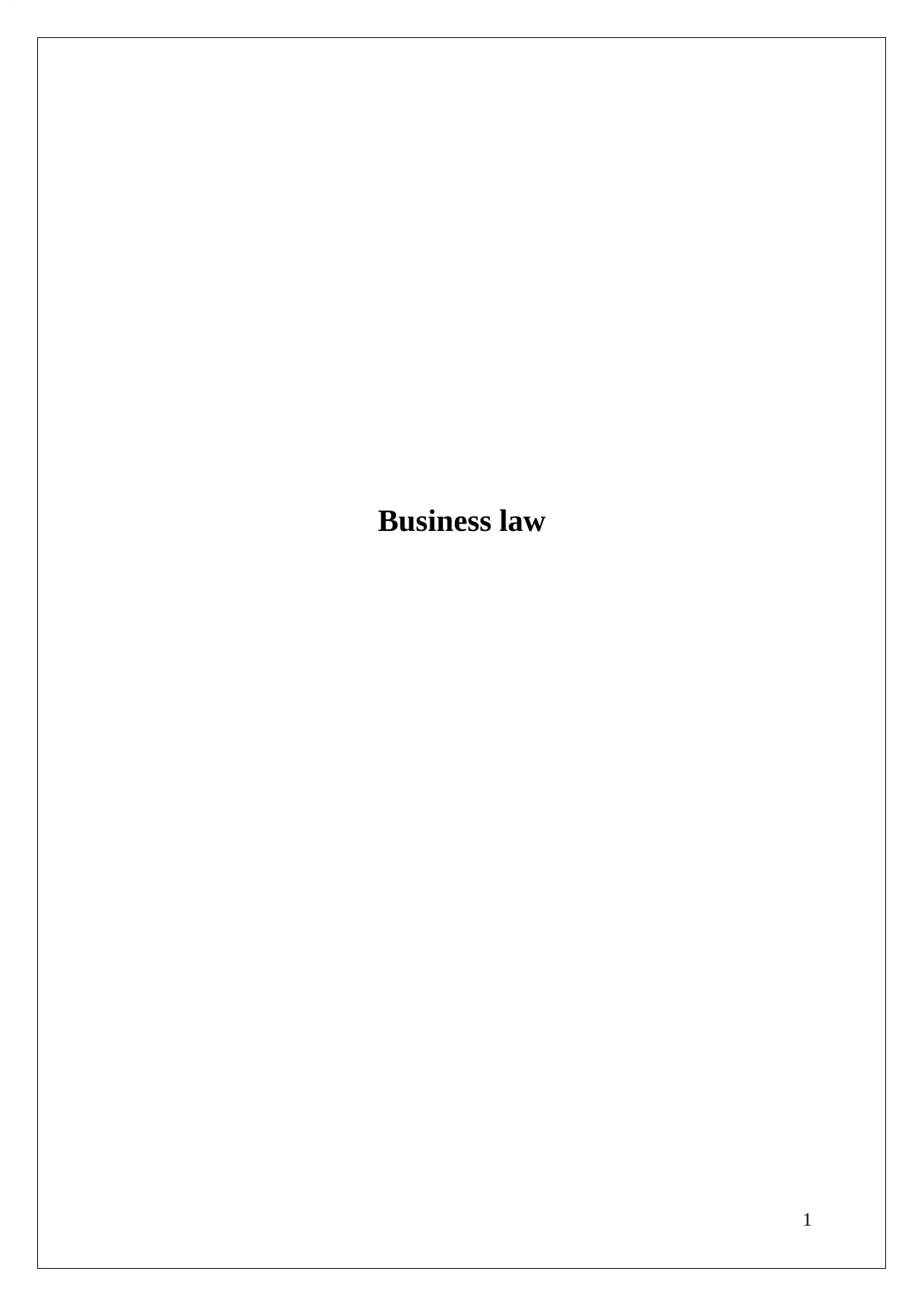
Business law
1
1
Paraphrase This Document
Need a fresh take? Get an instant paraphrase of this document with our AI Paraphraser
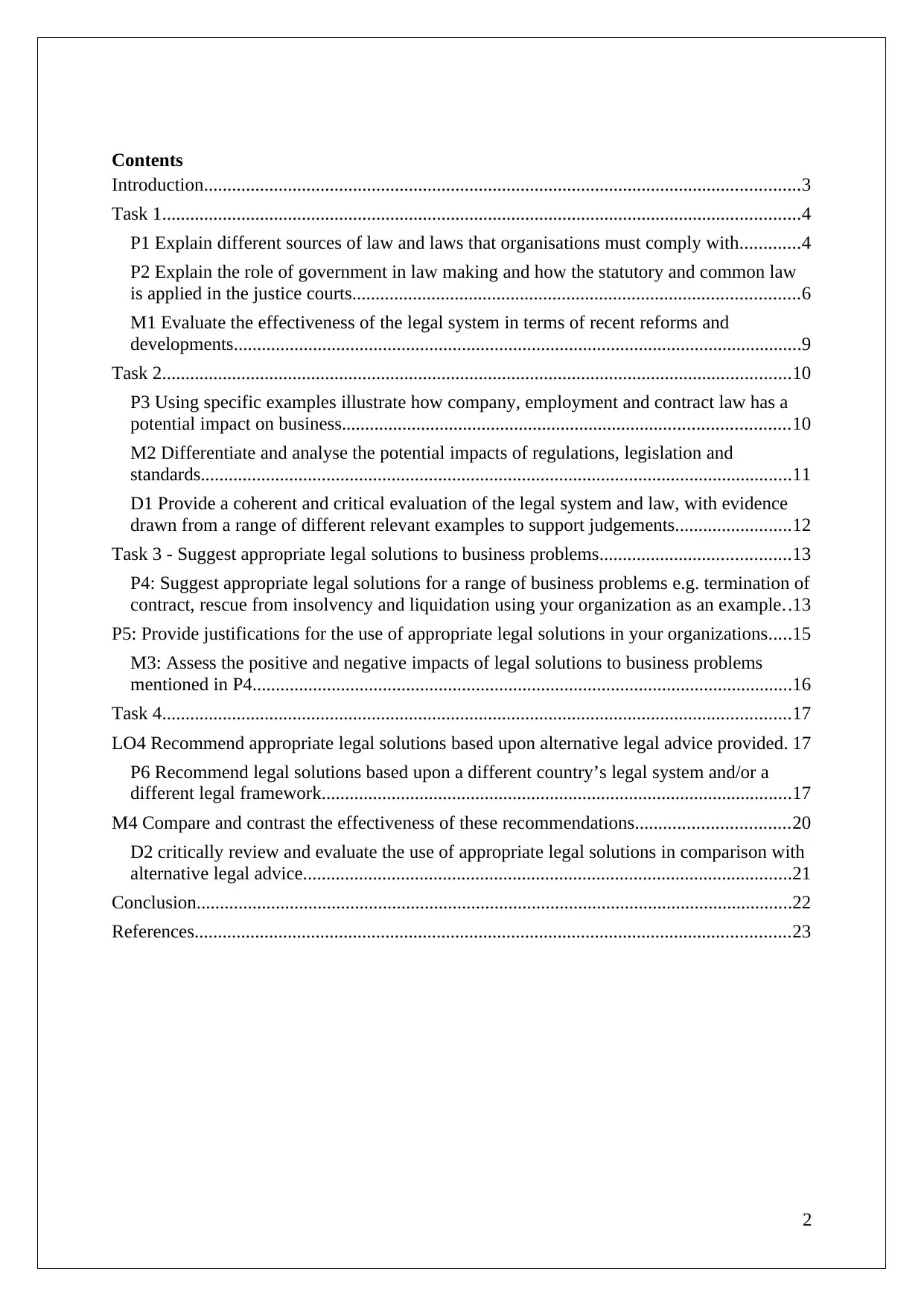
Contents
Introduction................................................................................................................................3
Task 1.........................................................................................................................................4
P1 Explain different sources of law and laws that organisations must comply with.............4
P2 Explain the role of government in law making and how the statutory and common law
is applied in the justice courts................................................................................................6
M1 Evaluate the effectiveness of the legal system in terms of recent reforms and
developments..........................................................................................................................9
Task 2.......................................................................................................................................10
P3 Using specific examples illustrate how company, employment and contract law has a
potential impact on business................................................................................................10
M2 Differentiate and analyse the potential impacts of regulations, legislation and
standards...............................................................................................................................11
D1 Provide a coherent and critical evaluation of the legal system and law, with evidence
drawn from a range of different relevant examples to support judgements.........................12
Task 3 - Suggest appropriate legal solutions to business problems.........................................13
P4: Suggest appropriate legal solutions for a range of business problems e.g. termination of
contract, rescue from insolvency and liquidation using your organization as an example..13
P5: Provide justifications for the use of appropriate legal solutions in your organizations.....15
M3: Assess the positive and negative impacts of legal solutions to business problems
mentioned in P4....................................................................................................................16
Task 4.......................................................................................................................................17
LO4 Recommend appropriate legal solutions based upon alternative legal advice provided. 17
P6 Recommend legal solutions based upon a different country’s legal system and/or a
different legal framework.....................................................................................................17
M4 Compare and contrast the effectiveness of these recommendations.................................20
D2 critically review and evaluate the use of appropriate legal solutions in comparison with
alternative legal advice.........................................................................................................21
Conclusion................................................................................................................................22
References................................................................................................................................23
2
Introduction................................................................................................................................3
Task 1.........................................................................................................................................4
P1 Explain different sources of law and laws that organisations must comply with.............4
P2 Explain the role of government in law making and how the statutory and common law
is applied in the justice courts................................................................................................6
M1 Evaluate the effectiveness of the legal system in terms of recent reforms and
developments..........................................................................................................................9
Task 2.......................................................................................................................................10
P3 Using specific examples illustrate how company, employment and contract law has a
potential impact on business................................................................................................10
M2 Differentiate and analyse the potential impacts of regulations, legislation and
standards...............................................................................................................................11
D1 Provide a coherent and critical evaluation of the legal system and law, with evidence
drawn from a range of different relevant examples to support judgements.........................12
Task 3 - Suggest appropriate legal solutions to business problems.........................................13
P4: Suggest appropriate legal solutions for a range of business problems e.g. termination of
contract, rescue from insolvency and liquidation using your organization as an example..13
P5: Provide justifications for the use of appropriate legal solutions in your organizations.....15
M3: Assess the positive and negative impacts of legal solutions to business problems
mentioned in P4....................................................................................................................16
Task 4.......................................................................................................................................17
LO4 Recommend appropriate legal solutions based upon alternative legal advice provided. 17
P6 Recommend legal solutions based upon a different country’s legal system and/or a
different legal framework.....................................................................................................17
M4 Compare and contrast the effectiveness of these recommendations.................................20
D2 critically review and evaluate the use of appropriate legal solutions in comparison with
alternative legal advice.........................................................................................................21
Conclusion................................................................................................................................22
References................................................................................................................................23
2
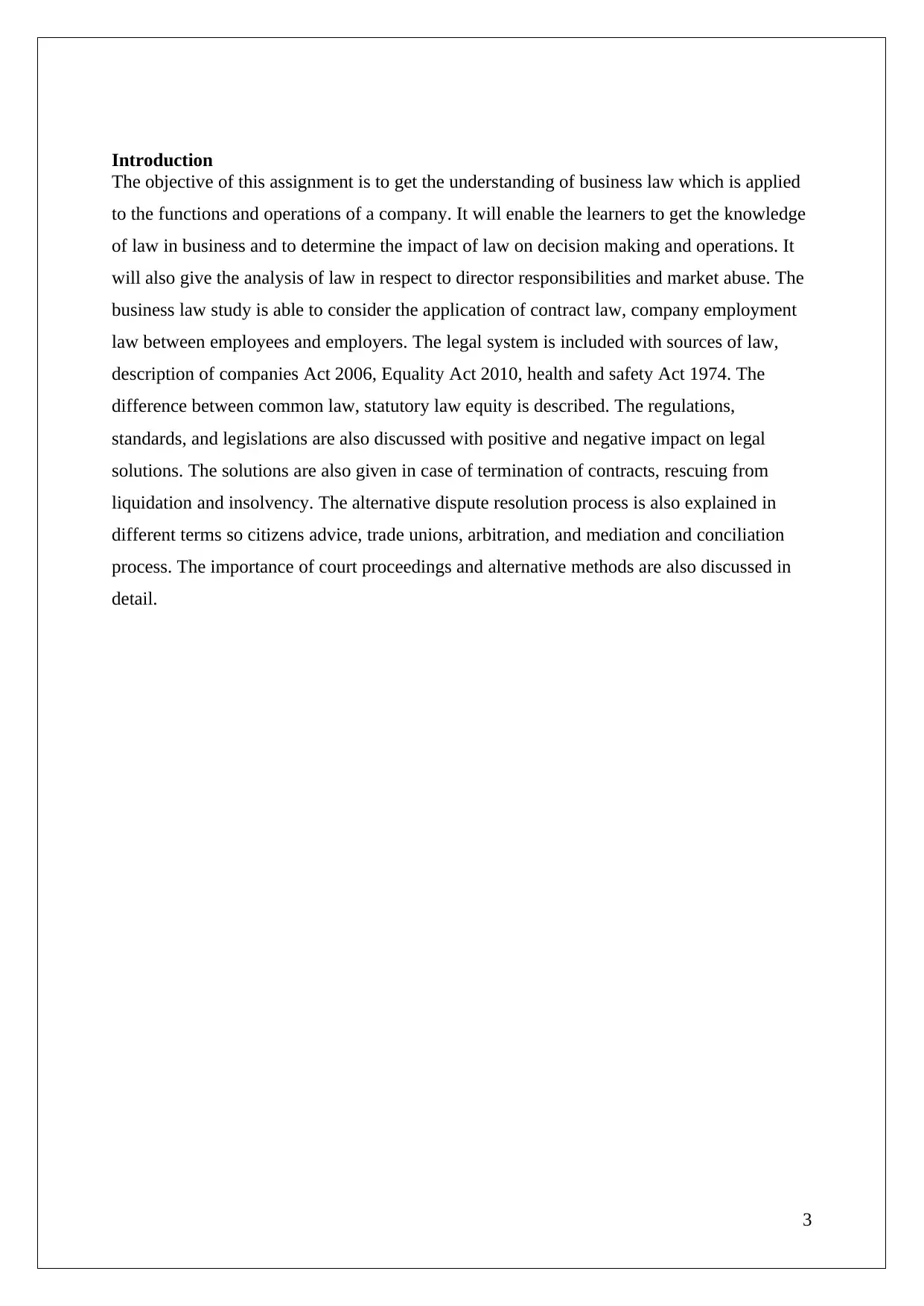
Introduction
The objective of this assignment is to get the understanding of business law which is applied
to the functions and operations of a company. It will enable the learners to get the knowledge
of law in business and to determine the impact of law on decision making and operations. It
will also give the analysis of law in respect to director responsibilities and market abuse. The
business law study is able to consider the application of contract law, company employment
law between employees and employers. The legal system is included with sources of law,
description of companies Act 2006, Equality Act 2010, health and safety Act 1974. The
difference between common law, statutory law equity is described. The regulations,
standards, and legislations are also discussed with positive and negative impact on legal
solutions. The solutions are also given in case of termination of contracts, rescuing from
liquidation and insolvency. The alternative dispute resolution process is also explained in
different terms so citizens advice, trade unions, arbitration, and mediation and conciliation
process. The importance of court proceedings and alternative methods are also discussed in
detail.
3
The objective of this assignment is to get the understanding of business law which is applied
to the functions and operations of a company. It will enable the learners to get the knowledge
of law in business and to determine the impact of law on decision making and operations. It
will also give the analysis of law in respect to director responsibilities and market abuse. The
business law study is able to consider the application of contract law, company employment
law between employees and employers. The legal system is included with sources of law,
description of companies Act 2006, Equality Act 2010, health and safety Act 1974. The
difference between common law, statutory law equity is described. The regulations,
standards, and legislations are also discussed with positive and negative impact on legal
solutions. The solutions are also given in case of termination of contracts, rescuing from
liquidation and insolvency. The alternative dispute resolution process is also explained in
different terms so citizens advice, trade unions, arbitration, and mediation and conciliation
process. The importance of court proceedings and alternative methods are also discussed in
detail.
3
⊘ This is a preview!⊘
Do you want full access?
Subscribe today to unlock all pages.

Trusted by 1+ million students worldwide
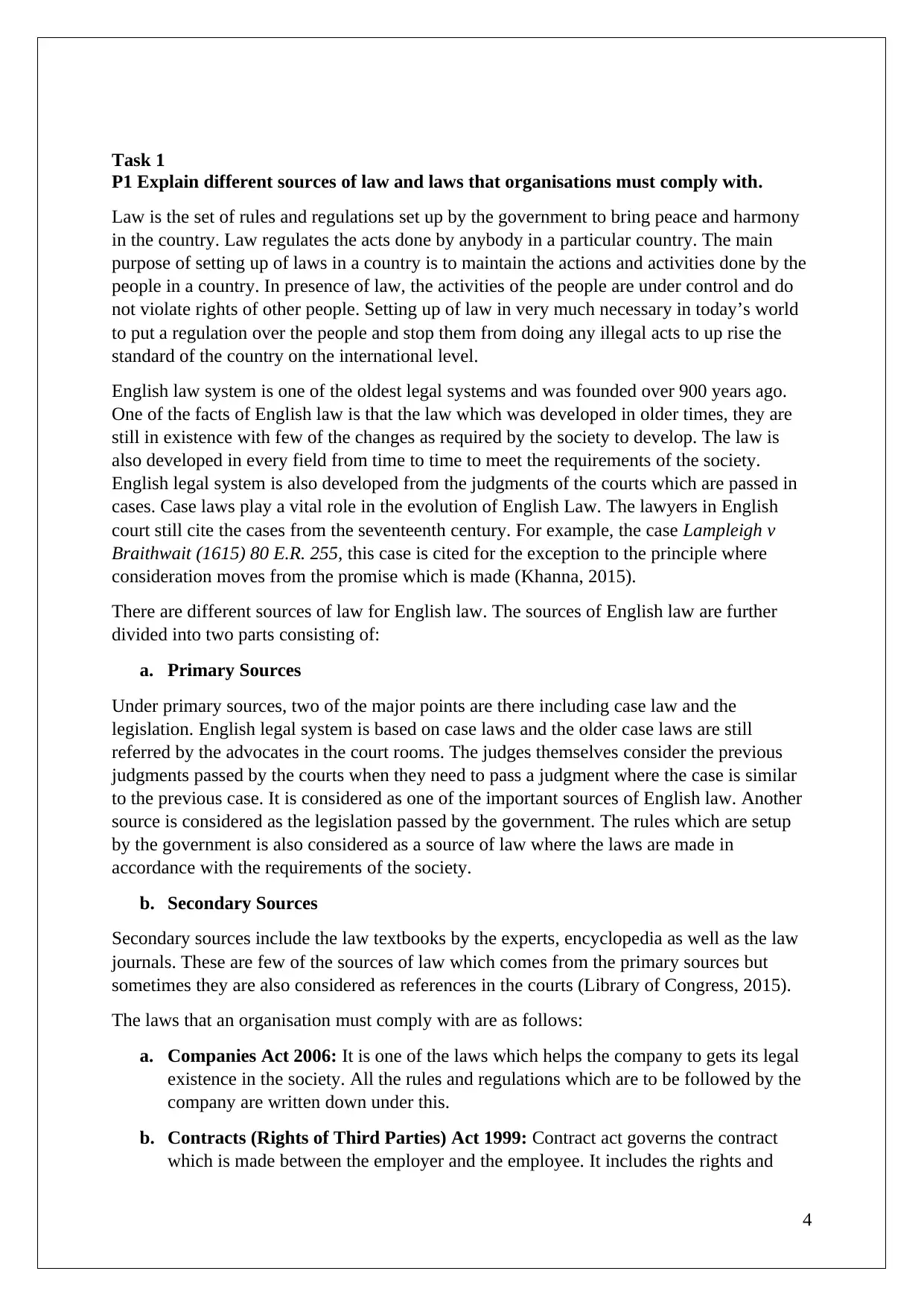
Task 1
P1 Explain different sources of law and laws that organisations must comply with.
Law is the set of rules and regulations set up by the government to bring peace and harmony
in the country. Law regulates the acts done by anybody in a particular country. The main
purpose of setting up of laws in a country is to maintain the actions and activities done by the
people in a country. In presence of law, the activities of the people are under control and do
not violate rights of other people. Setting up of law in very much necessary in today’s world
to put a regulation over the people and stop them from doing any illegal acts to up rise the
standard of the country on the international level.
English law system is one of the oldest legal systems and was founded over 900 years ago.
One of the facts of English law is that the law which was developed in older times, they are
still in existence with few of the changes as required by the society to develop. The law is
also developed in every field from time to time to meet the requirements of the society.
English legal system is also developed from the judgments of the courts which are passed in
cases. Case laws play a vital role in the evolution of English Law. The lawyers in English
court still cite the cases from the seventeenth century. For example, the case Lampleigh v
Braithwait (1615) 80 E.R. 255, this case is cited for the exception to the principle where
consideration moves from the promise which is made (Khanna, 2015).
There are different sources of law for English law. The sources of English law are further
divided into two parts consisting of:
a. Primary Sources
Under primary sources, two of the major points are there including case law and the
legislation. English legal system is based on case laws and the older case laws are still
referred by the advocates in the court rooms. The judges themselves consider the previous
judgments passed by the courts when they need to pass a judgment where the case is similar
to the previous case. It is considered as one of the important sources of English law. Another
source is considered as the legislation passed by the government. The rules which are setup
by the government is also considered as a source of law where the laws are made in
accordance with the requirements of the society.
b. Secondary Sources
Secondary sources include the law textbooks by the experts, encyclopedia as well as the law
journals. These are few of the sources of law which comes from the primary sources but
sometimes they are also considered as references in the courts (Library of Congress, 2015).
The laws that an organisation must comply with are as follows:
a. Companies Act 2006: It is one of the laws which helps the company to gets its legal
existence in the society. All the rules and regulations which are to be followed by the
company are written down under this.
b. Contracts (Rights of Third Parties) Act 1999: Contract act governs the contract
which is made between the employer and the employee. It includes the rights and
4
P1 Explain different sources of law and laws that organisations must comply with.
Law is the set of rules and regulations set up by the government to bring peace and harmony
in the country. Law regulates the acts done by anybody in a particular country. The main
purpose of setting up of laws in a country is to maintain the actions and activities done by the
people in a country. In presence of law, the activities of the people are under control and do
not violate rights of other people. Setting up of law in very much necessary in today’s world
to put a regulation over the people and stop them from doing any illegal acts to up rise the
standard of the country on the international level.
English law system is one of the oldest legal systems and was founded over 900 years ago.
One of the facts of English law is that the law which was developed in older times, they are
still in existence with few of the changes as required by the society to develop. The law is
also developed in every field from time to time to meet the requirements of the society.
English legal system is also developed from the judgments of the courts which are passed in
cases. Case laws play a vital role in the evolution of English Law. The lawyers in English
court still cite the cases from the seventeenth century. For example, the case Lampleigh v
Braithwait (1615) 80 E.R. 255, this case is cited for the exception to the principle where
consideration moves from the promise which is made (Khanna, 2015).
There are different sources of law for English law. The sources of English law are further
divided into two parts consisting of:
a. Primary Sources
Under primary sources, two of the major points are there including case law and the
legislation. English legal system is based on case laws and the older case laws are still
referred by the advocates in the court rooms. The judges themselves consider the previous
judgments passed by the courts when they need to pass a judgment where the case is similar
to the previous case. It is considered as one of the important sources of English law. Another
source is considered as the legislation passed by the government. The rules which are setup
by the government is also considered as a source of law where the laws are made in
accordance with the requirements of the society.
b. Secondary Sources
Secondary sources include the law textbooks by the experts, encyclopedia as well as the law
journals. These are few of the sources of law which comes from the primary sources but
sometimes they are also considered as references in the courts (Library of Congress, 2015).
The laws that an organisation must comply with are as follows:
a. Companies Act 2006: It is one of the laws which helps the company to gets its legal
existence in the society. All the rules and regulations which are to be followed by the
company are written down under this.
b. Contracts (Rights of Third Parties) Act 1999: Contract act governs the contract
which is made between the employer and the employee. It includes the rights and
4
Paraphrase This Document
Need a fresh take? Get an instant paraphrase of this document with our AI Paraphraser
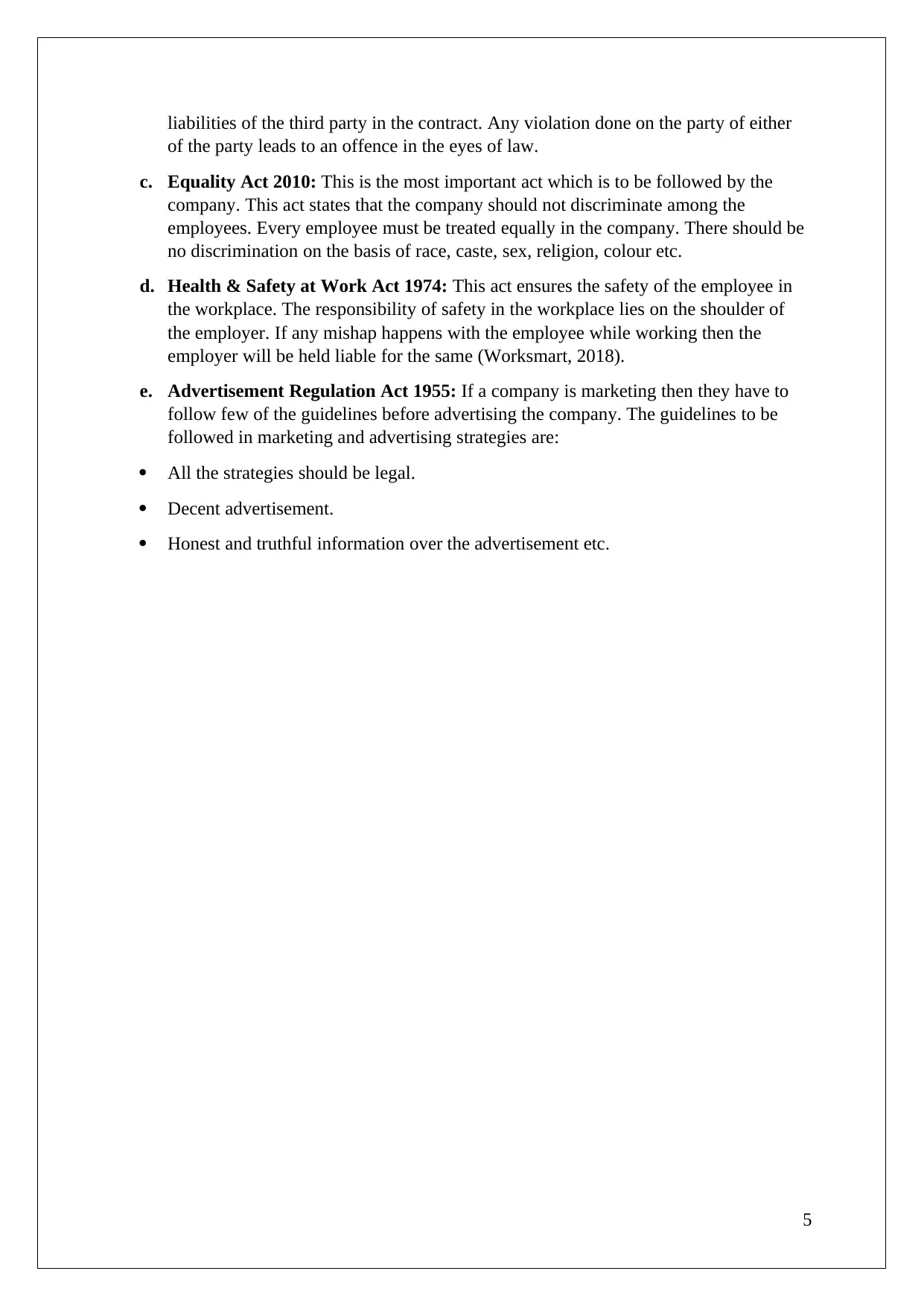
liabilities of the third party in the contract. Any violation done on the party of either
of the party leads to an offence in the eyes of law.
c. Equality Act 2010: This is the most important act which is to be followed by the
company. This act states that the company should not discriminate among the
employees. Every employee must be treated equally in the company. There should be
no discrimination on the basis of race, caste, sex, religion, colour etc.
d. Health & Safety at Work Act 1974: This act ensures the safety of the employee in
the workplace. The responsibility of safety in the workplace lies on the shoulder of
the employer. If any mishap happens with the employee while working then the
employer will be held liable for the same (Worksmart, 2018).
e. Advertisement Regulation Act 1955: If a company is marketing then they have to
follow few of the guidelines before advertising the company. The guidelines to be
followed in marketing and advertising strategies are:
All the strategies should be legal.
Decent advertisement.
Honest and truthful information over the advertisement etc.
5
of the party leads to an offence in the eyes of law.
c. Equality Act 2010: This is the most important act which is to be followed by the
company. This act states that the company should not discriminate among the
employees. Every employee must be treated equally in the company. There should be
no discrimination on the basis of race, caste, sex, religion, colour etc.
d. Health & Safety at Work Act 1974: This act ensures the safety of the employee in
the workplace. The responsibility of safety in the workplace lies on the shoulder of
the employer. If any mishap happens with the employee while working then the
employer will be held liable for the same (Worksmart, 2018).
e. Advertisement Regulation Act 1955: If a company is marketing then they have to
follow few of the guidelines before advertising the company. The guidelines to be
followed in marketing and advertising strategies are:
All the strategies should be legal.
Decent advertisement.
Honest and truthful information over the advertisement etc.
5
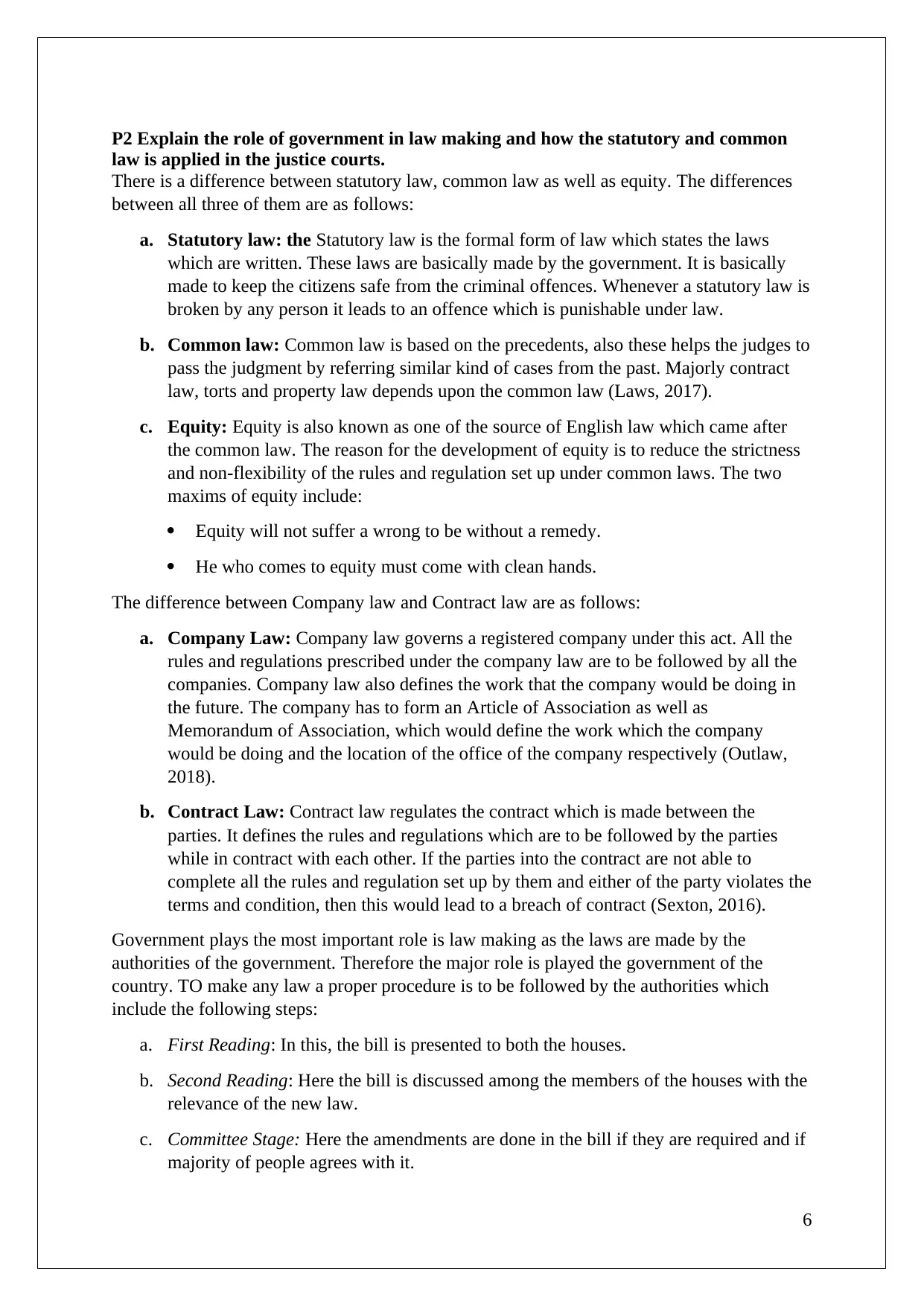
P2 Explain the role of government in law making and how the statutory and common
law is applied in the justice courts.
There is a difference between statutory law, common law as well as equity. The differences
between all three of them are as follows:
a. Statutory law: the Statutory law is the formal form of law which states the laws
which are written. These laws are basically made by the government. It is basically
made to keep the citizens safe from the criminal offences. Whenever a statutory law is
broken by any person it leads to an offence which is punishable under law.
b. Common law: Common law is based on the precedents, also these helps the judges to
pass the judgment by referring similar kind of cases from the past. Majorly contract
law, torts and property law depends upon the common law (Laws, 2017).
c. Equity: Equity is also known as one of the source of English law which came after
the common law. The reason for the development of equity is to reduce the strictness
and non-flexibility of the rules and regulation set up under common laws. The two
maxims of equity include:
Equity will not suffer a wrong to be without a remedy.
He who comes to equity must come with clean hands.
The difference between Company law and Contract law are as follows:
a. Company Law: Company law governs a registered company under this act. All the
rules and regulations prescribed under the company law are to be followed by all the
companies. Company law also defines the work that the company would be doing in
the future. The company has to form an Article of Association as well as
Memorandum of Association, which would define the work which the company
would be doing and the location of the office of the company respectively (Outlaw,
2018).
b. Contract Law: Contract law regulates the contract which is made between the
parties. It defines the rules and regulations which are to be followed by the parties
while in contract with each other. If the parties into the contract are not able to
complete all the rules and regulation set up by them and either of the party violates the
terms and condition, then this would lead to a breach of contract (Sexton, 2016).
Government plays the most important role is law making as the laws are made by the
authorities of the government. Therefore the major role is played the government of the
country. TO make any law a proper procedure is to be followed by the authorities which
include the following steps:
a. First Reading: In this, the bill is presented to both the houses.
b. Second Reading: Here the bill is discussed among the members of the houses with the
relevance of the new law.
c. Committee Stage: Here the amendments are done in the bill if they are required and if
majority of people agrees with it.
6
law is applied in the justice courts.
There is a difference between statutory law, common law as well as equity. The differences
between all three of them are as follows:
a. Statutory law: the Statutory law is the formal form of law which states the laws
which are written. These laws are basically made by the government. It is basically
made to keep the citizens safe from the criminal offences. Whenever a statutory law is
broken by any person it leads to an offence which is punishable under law.
b. Common law: Common law is based on the precedents, also these helps the judges to
pass the judgment by referring similar kind of cases from the past. Majorly contract
law, torts and property law depends upon the common law (Laws, 2017).
c. Equity: Equity is also known as one of the source of English law which came after
the common law. The reason for the development of equity is to reduce the strictness
and non-flexibility of the rules and regulation set up under common laws. The two
maxims of equity include:
Equity will not suffer a wrong to be without a remedy.
He who comes to equity must come with clean hands.
The difference between Company law and Contract law are as follows:
a. Company Law: Company law governs a registered company under this act. All the
rules and regulations prescribed under the company law are to be followed by all the
companies. Company law also defines the work that the company would be doing in
the future. The company has to form an Article of Association as well as
Memorandum of Association, which would define the work which the company
would be doing and the location of the office of the company respectively (Outlaw,
2018).
b. Contract Law: Contract law regulates the contract which is made between the
parties. It defines the rules and regulations which are to be followed by the parties
while in contract with each other. If the parties into the contract are not able to
complete all the rules and regulation set up by them and either of the party violates the
terms and condition, then this would lead to a breach of contract (Sexton, 2016).
Government plays the most important role is law making as the laws are made by the
authorities of the government. Therefore the major role is played the government of the
country. TO make any law a proper procedure is to be followed by the authorities which
include the following steps:
a. First Reading: In this, the bill is presented to both the houses.
b. Second Reading: Here the bill is discussed among the members of the houses with the
relevance of the new law.
c. Committee Stage: Here the amendments are done in the bill if they are required and if
majority of people agrees with it.
6
⊘ This is a preview!⊘
Do you want full access?
Subscribe today to unlock all pages.

Trusted by 1+ million students worldwide
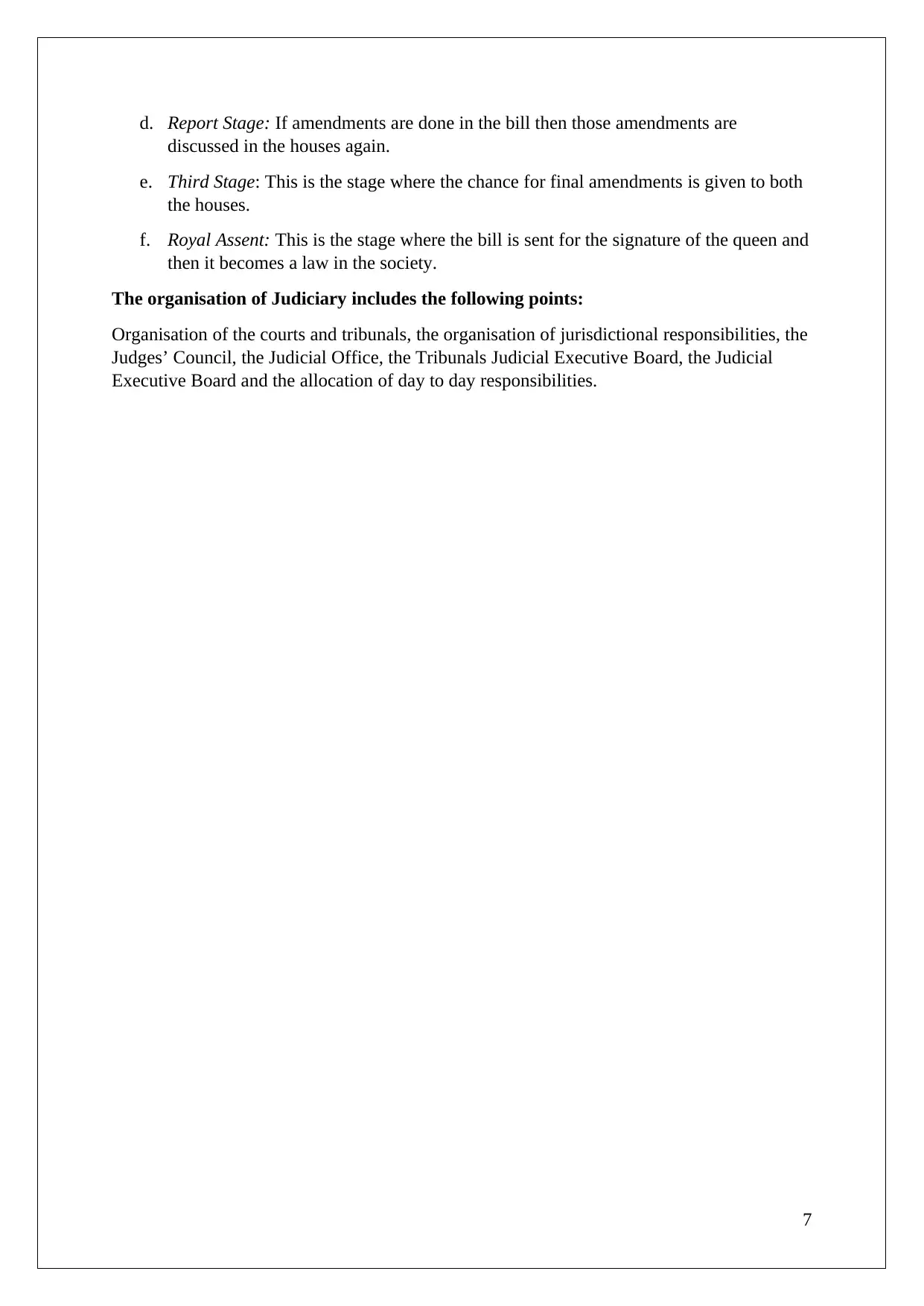
d. Report Stage: If amendments are done in the bill then those amendments are
discussed in the houses again.
e. Third Stage: This is the stage where the chance for final amendments is given to both
the houses.
f. Royal Assent: This is the stage where the bill is sent for the signature of the queen and
then it becomes a law in the society.
The organisation of Judiciary includes the following points:
Organisation of the courts and tribunals, the organisation of jurisdictional responsibilities, the
Judges’ Council, the Judicial Office, the Tribunals Judicial Executive Board, the Judicial
Executive Board and the allocation of day to day responsibilities.
7
discussed in the houses again.
e. Third Stage: This is the stage where the chance for final amendments is given to both
the houses.
f. Royal Assent: This is the stage where the bill is sent for the signature of the queen and
then it becomes a law in the society.
The organisation of Judiciary includes the following points:
Organisation of the courts and tribunals, the organisation of jurisdictional responsibilities, the
Judges’ Council, the Judicial Office, the Tribunals Judicial Executive Board, the Judicial
Executive Board and the allocation of day to day responsibilities.
7
Paraphrase This Document
Need a fresh take? Get an instant paraphrase of this document with our AI Paraphraser
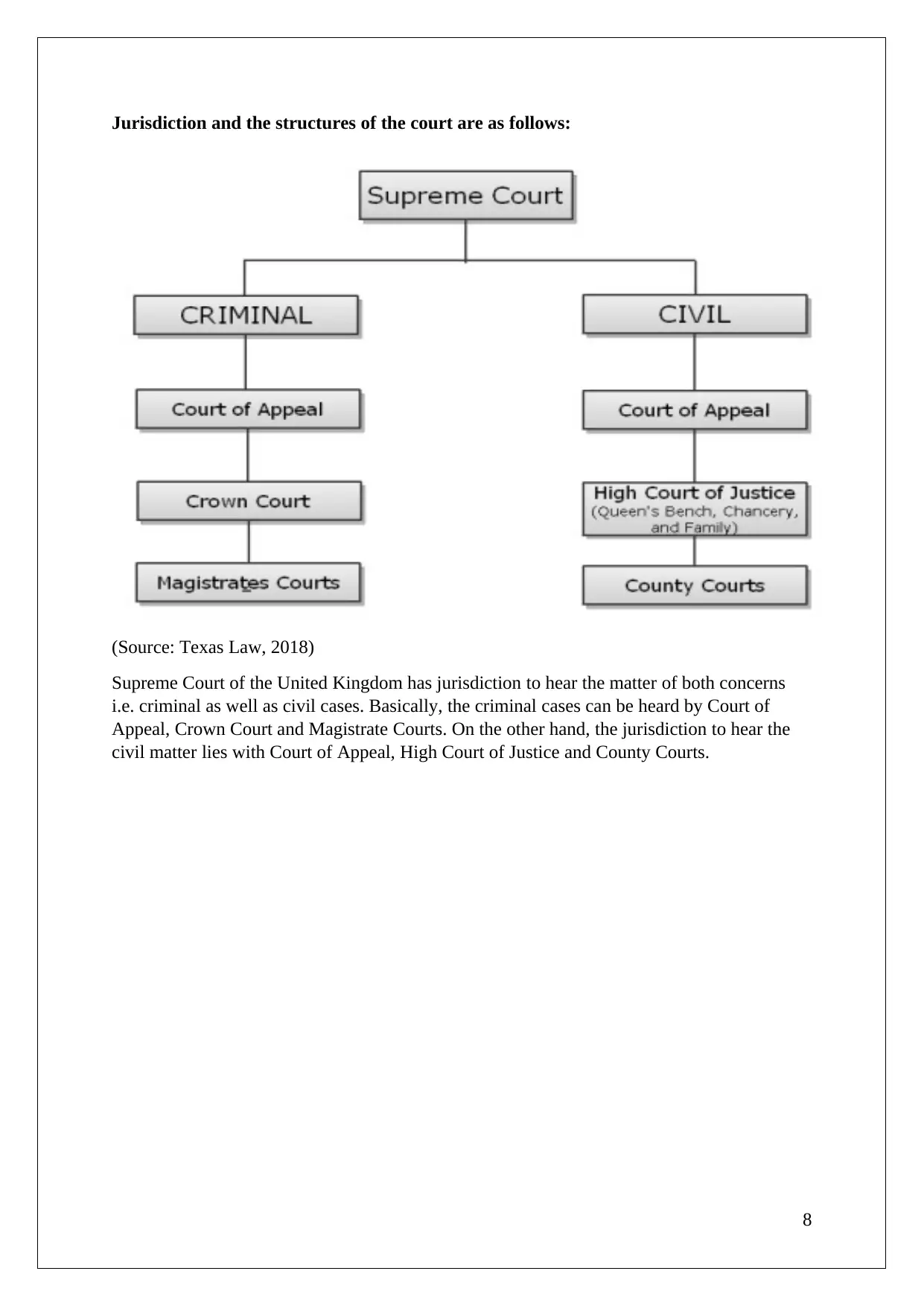
Jurisdiction and the structures of the court are as follows:
(Source: Texas Law, 2018)
Supreme Court of the United Kingdom has jurisdiction to hear the matter of both concerns
i.e. criminal as well as civil cases. Basically, the criminal cases can be heard by Court of
Appeal, Crown Court and Magistrate Courts. On the other hand, the jurisdiction to hear the
civil matter lies with Court of Appeal, High Court of Justice and County Courts.
8
(Source: Texas Law, 2018)
Supreme Court of the United Kingdom has jurisdiction to hear the matter of both concerns
i.e. criminal as well as civil cases. Basically, the criminal cases can be heard by Court of
Appeal, Crown Court and Magistrate Courts. On the other hand, the jurisdiction to hear the
civil matter lies with Court of Appeal, High Court of Justice and County Courts.
8
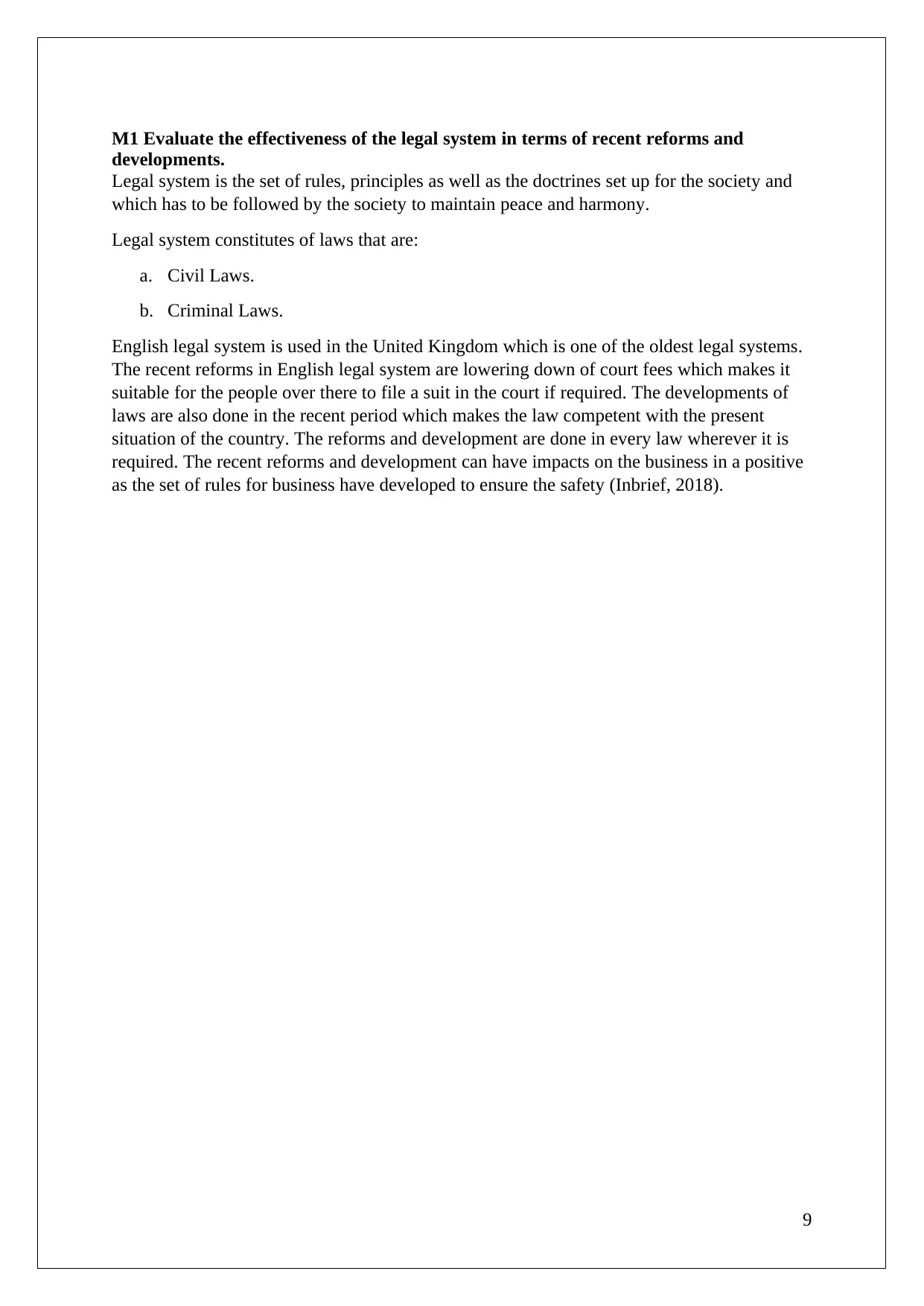
M1 Evaluate the effectiveness of the legal system in terms of recent reforms and
developments.
Legal system is the set of rules, principles as well as the doctrines set up for the society and
which has to be followed by the society to maintain peace and harmony.
Legal system constitutes of laws that are:
a. Civil Laws.
b. Criminal Laws.
English legal system is used in the United Kingdom which is one of the oldest legal systems.
The recent reforms in English legal system are lowering down of court fees which makes it
suitable for the people over there to file a suit in the court if required. The developments of
laws are also done in the recent period which makes the law competent with the present
situation of the country. The reforms and development are done in every law wherever it is
required. The recent reforms and development can have impacts on the business in a positive
as the set of rules for business have developed to ensure the safety (Inbrief, 2018).
9
developments.
Legal system is the set of rules, principles as well as the doctrines set up for the society and
which has to be followed by the society to maintain peace and harmony.
Legal system constitutes of laws that are:
a. Civil Laws.
b. Criminal Laws.
English legal system is used in the United Kingdom which is one of the oldest legal systems.
The recent reforms in English legal system are lowering down of court fees which makes it
suitable for the people over there to file a suit in the court if required. The developments of
laws are also done in the recent period which makes the law competent with the present
situation of the country. The reforms and development are done in every law wherever it is
required. The recent reforms and development can have impacts on the business in a positive
as the set of rules for business have developed to ensure the safety (Inbrief, 2018).
9
⊘ This is a preview!⊘
Do you want full access?
Subscribe today to unlock all pages.

Trusted by 1+ million students worldwide
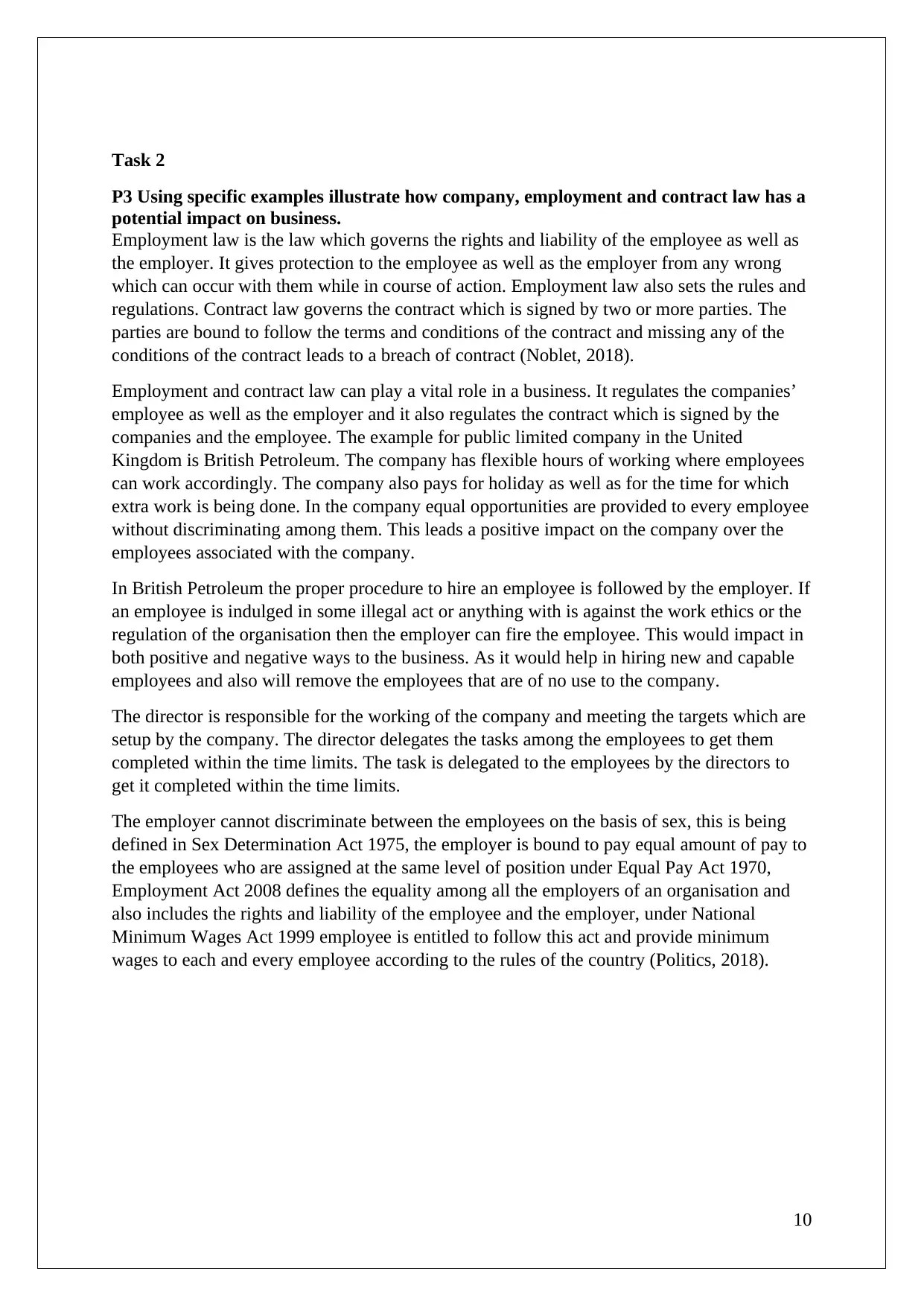
Task 2
P3 Using specific examples illustrate how company, employment and contract law has a
potential impact on business.
Employment law is the law which governs the rights and liability of the employee as well as
the employer. It gives protection to the employee as well as the employer from any wrong
which can occur with them while in course of action. Employment law also sets the rules and
regulations. Contract law governs the contract which is signed by two or more parties. The
parties are bound to follow the terms and conditions of the contract and missing any of the
conditions of the contract leads to a breach of contract (Noblet, 2018).
Employment and contract law can play a vital role in a business. It regulates the companies’
employee as well as the employer and it also regulates the contract which is signed by the
companies and the employee. The example for public limited company in the United
Kingdom is British Petroleum. The company has flexible hours of working where employees
can work accordingly. The company also pays for holiday as well as for the time for which
extra work is being done. In the company equal opportunities are provided to every employee
without discriminating among them. This leads a positive impact on the company over the
employees associated with the company.
In British Petroleum the proper procedure to hire an employee is followed by the employer. If
an employee is indulged in some illegal act or anything with is against the work ethics or the
regulation of the organisation then the employer can fire the employee. This would impact in
both positive and negative ways to the business. As it would help in hiring new and capable
employees and also will remove the employees that are of no use to the company.
The director is responsible for the working of the company and meeting the targets which are
setup by the company. The director delegates the tasks among the employees to get them
completed within the time limits. The task is delegated to the employees by the directors to
get it completed within the time limits.
The employer cannot discriminate between the employees on the basis of sex, this is being
defined in Sex Determination Act 1975, the employer is bound to pay equal amount of pay to
the employees who are assigned at the same level of position under Equal Pay Act 1970,
Employment Act 2008 defines the equality among all the employers of an organisation and
also includes the rights and liability of the employee and the employer, under National
Minimum Wages Act 1999 employee is entitled to follow this act and provide minimum
wages to each and every employee according to the rules of the country (Politics, 2018).
10
P3 Using specific examples illustrate how company, employment and contract law has a
potential impact on business.
Employment law is the law which governs the rights and liability of the employee as well as
the employer. It gives protection to the employee as well as the employer from any wrong
which can occur with them while in course of action. Employment law also sets the rules and
regulations. Contract law governs the contract which is signed by two or more parties. The
parties are bound to follow the terms and conditions of the contract and missing any of the
conditions of the contract leads to a breach of contract (Noblet, 2018).
Employment and contract law can play a vital role in a business. It regulates the companies’
employee as well as the employer and it also regulates the contract which is signed by the
companies and the employee. The example for public limited company in the United
Kingdom is British Petroleum. The company has flexible hours of working where employees
can work accordingly. The company also pays for holiday as well as for the time for which
extra work is being done. In the company equal opportunities are provided to every employee
without discriminating among them. This leads a positive impact on the company over the
employees associated with the company.
In British Petroleum the proper procedure to hire an employee is followed by the employer. If
an employee is indulged in some illegal act or anything with is against the work ethics or the
regulation of the organisation then the employer can fire the employee. This would impact in
both positive and negative ways to the business. As it would help in hiring new and capable
employees and also will remove the employees that are of no use to the company.
The director is responsible for the working of the company and meeting the targets which are
setup by the company. The director delegates the tasks among the employees to get them
completed within the time limits. The task is delegated to the employees by the directors to
get it completed within the time limits.
The employer cannot discriminate between the employees on the basis of sex, this is being
defined in Sex Determination Act 1975, the employer is bound to pay equal amount of pay to
the employees who are assigned at the same level of position under Equal Pay Act 1970,
Employment Act 2008 defines the equality among all the employers of an organisation and
also includes the rights and liability of the employee and the employer, under National
Minimum Wages Act 1999 employee is entitled to follow this act and provide minimum
wages to each and every employee according to the rules of the country (Politics, 2018).
10
Paraphrase This Document
Need a fresh take? Get an instant paraphrase of this document with our AI Paraphraser
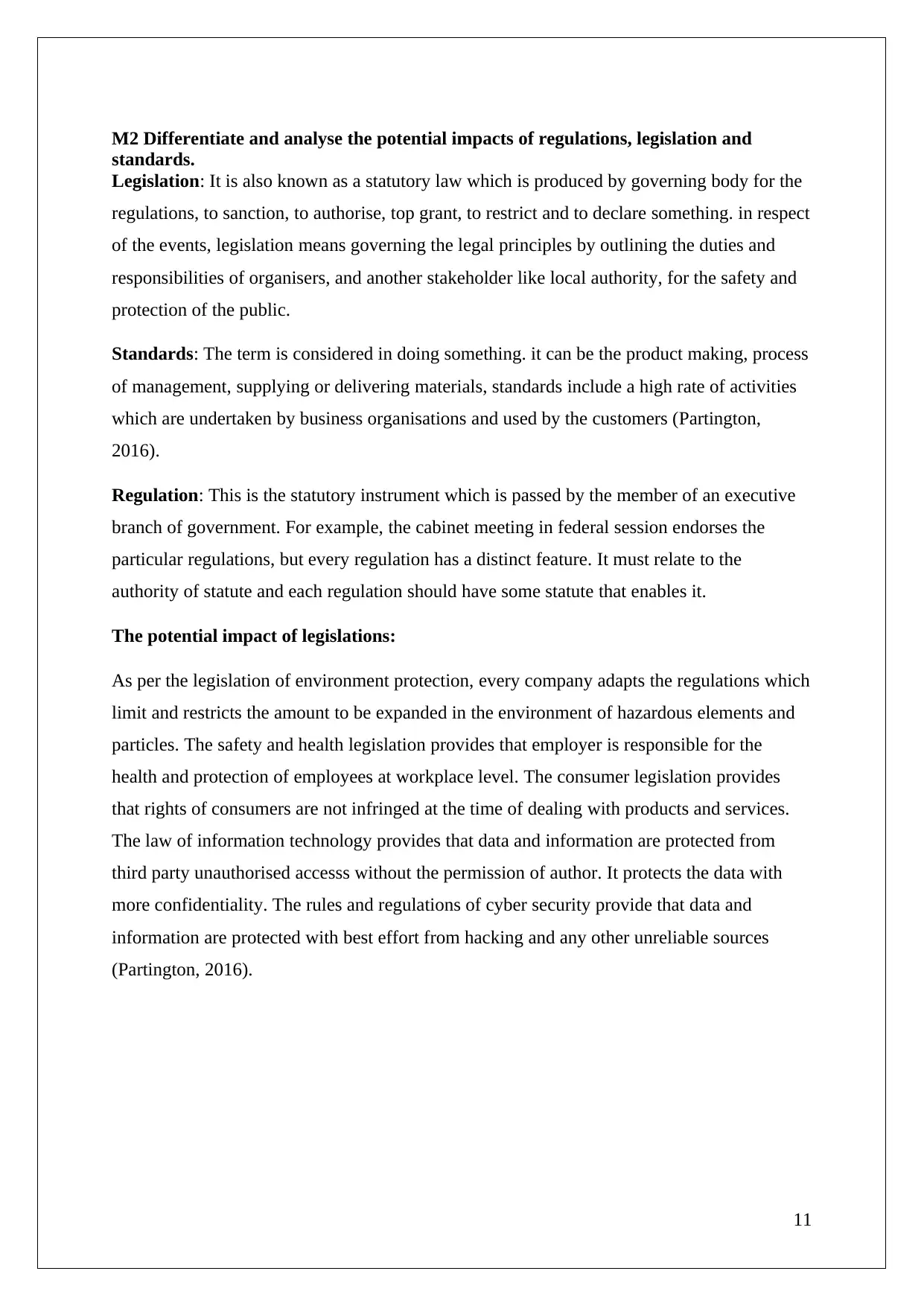
M2 Differentiate and analyse the potential impacts of regulations, legislation and
standards.
Legislation: It is also known as a statutory law which is produced by governing body for the
regulations, to sanction, to authorise, top grant, to restrict and to declare something. in respect
of the events, legislation means governing the legal principles by outlining the duties and
responsibilities of organisers, and another stakeholder like local authority, for the safety and
protection of the public.
Standards: The term is considered in doing something. it can be the product making, process
of management, supplying or delivering materials, standards include a high rate of activities
which are undertaken by business organisations and used by the customers (Partington,
2016).
Regulation: This is the statutory instrument which is passed by the member of an executive
branch of government. For example, the cabinet meeting in federal session endorses the
particular regulations, but every regulation has a distinct feature. It must relate to the
authority of statute and each regulation should have some statute that enables it.
The potential impact of legislations:
As per the legislation of environment protection, every company adapts the regulations which
limit and restricts the amount to be expanded in the environment of hazardous elements and
particles. The safety and health legislation provides that employer is responsible for the
health and protection of employees at workplace level. The consumer legislation provides
that rights of consumers are not infringed at the time of dealing with products and services.
The law of information technology provides that data and information are protected from
third party unauthorised accesss without the permission of author. It protects the data with
more confidentiality. The rules and regulations of cyber security provide that data and
information are protected with best effort from hacking and any other unreliable sources
(Partington, 2016).
11
standards.
Legislation: It is also known as a statutory law which is produced by governing body for the
regulations, to sanction, to authorise, top grant, to restrict and to declare something. in respect
of the events, legislation means governing the legal principles by outlining the duties and
responsibilities of organisers, and another stakeholder like local authority, for the safety and
protection of the public.
Standards: The term is considered in doing something. it can be the product making, process
of management, supplying or delivering materials, standards include a high rate of activities
which are undertaken by business organisations and used by the customers (Partington,
2016).
Regulation: This is the statutory instrument which is passed by the member of an executive
branch of government. For example, the cabinet meeting in federal session endorses the
particular regulations, but every regulation has a distinct feature. It must relate to the
authority of statute and each regulation should have some statute that enables it.
The potential impact of legislations:
As per the legislation of environment protection, every company adapts the regulations which
limit and restricts the amount to be expanded in the environment of hazardous elements and
particles. The safety and health legislation provides that employer is responsible for the
health and protection of employees at workplace level. The consumer legislation provides
that rights of consumers are not infringed at the time of dealing with products and services.
The law of information technology provides that data and information are protected from
third party unauthorised accesss without the permission of author. It protects the data with
more confidentiality. The rules and regulations of cyber security provide that data and
information are protected with best effort from hacking and any other unreliable sources
(Partington, 2016).
11
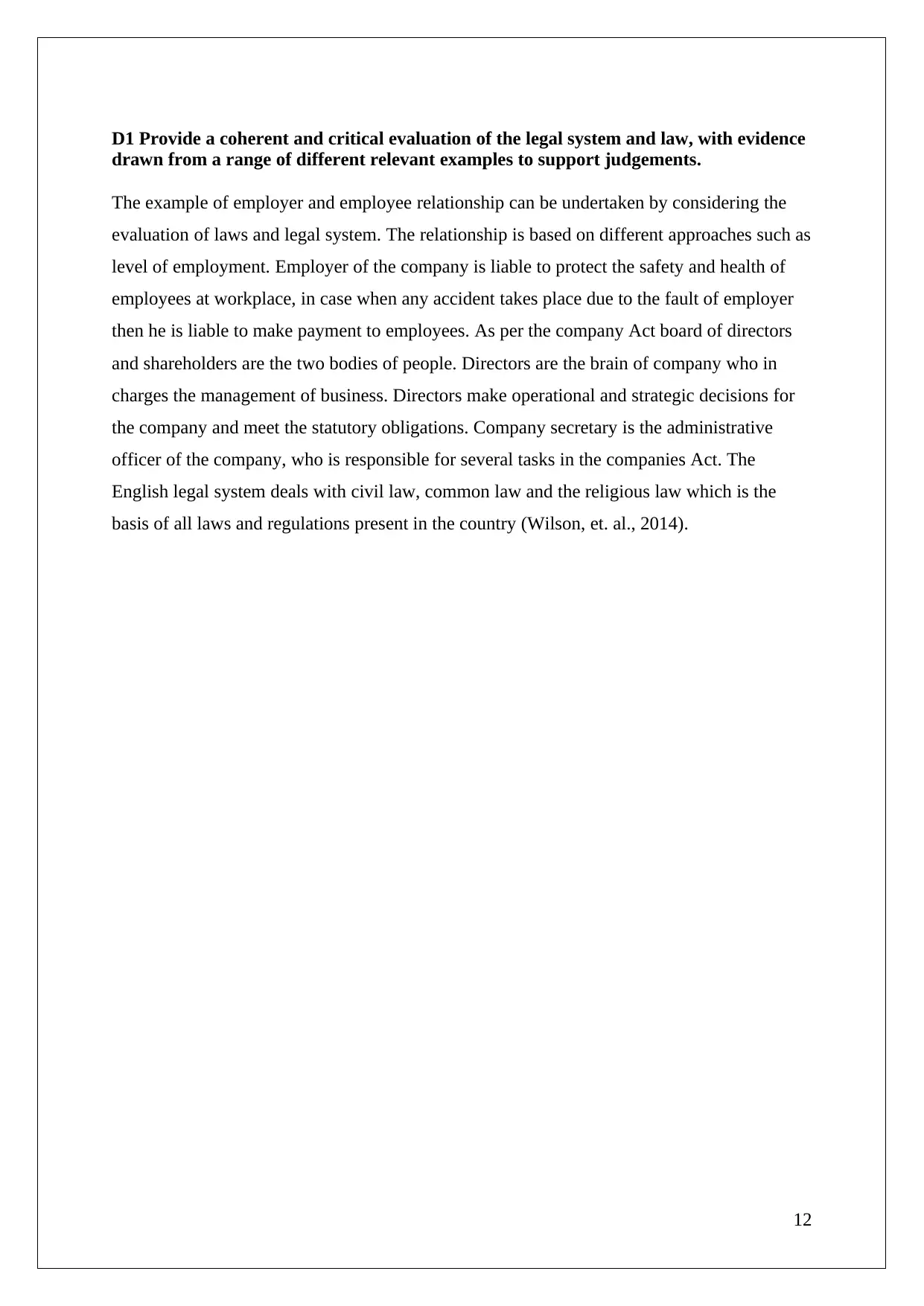
D1 Provide a coherent and critical evaluation of the legal system and law, with evidence
drawn from a range of different relevant examples to support judgements.
The example of employer and employee relationship can be undertaken by considering the
evaluation of laws and legal system. The relationship is based on different approaches such as
level of employment. Employer of the company is liable to protect the safety and health of
employees at workplace, in case when any accident takes place due to the fault of employer
then he is liable to make payment to employees. As per the company Act board of directors
and shareholders are the two bodies of people. Directors are the brain of company who in
charges the management of business. Directors make operational and strategic decisions for
the company and meet the statutory obligations. Company secretary is the administrative
officer of the company, who is responsible for several tasks in the companies Act. The
English legal system deals with civil law, common law and the religious law which is the
basis of all laws and regulations present in the country (Wilson, et. al., 2014).
12
drawn from a range of different relevant examples to support judgements.
The example of employer and employee relationship can be undertaken by considering the
evaluation of laws and legal system. The relationship is based on different approaches such as
level of employment. Employer of the company is liable to protect the safety and health of
employees at workplace, in case when any accident takes place due to the fault of employer
then he is liable to make payment to employees. As per the company Act board of directors
and shareholders are the two bodies of people. Directors are the brain of company who in
charges the management of business. Directors make operational and strategic decisions for
the company and meet the statutory obligations. Company secretary is the administrative
officer of the company, who is responsible for several tasks in the companies Act. The
English legal system deals with civil law, common law and the religious law which is the
basis of all laws and regulations present in the country (Wilson, et. al., 2014).
12
⊘ This is a preview!⊘
Do you want full access?
Subscribe today to unlock all pages.

Trusted by 1+ million students worldwide
1 out of 25
Related Documents
Your All-in-One AI-Powered Toolkit for Academic Success.
+13062052269
info@desklib.com
Available 24*7 on WhatsApp / Email
![[object Object]](/_next/static/media/star-bottom.7253800d.svg)
Unlock your academic potential
Copyright © 2020–2025 A2Z Services. All Rights Reserved. Developed and managed by ZUCOL.





